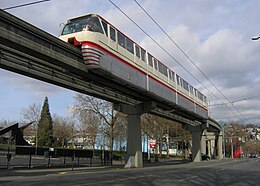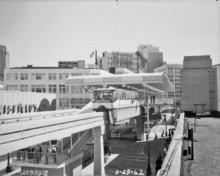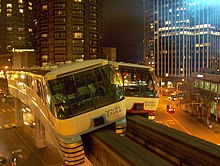Seattle monorail

The Seattle Center Monorail connects under the name Seattle Center Monorail , the northern city of Seattle to the site of the Great Exhibition of 1962 , on the various cultural institutions such as the Space Needle , the Pacific Science Center or the EPM Museum can be found. The railway was built according to the ALWEG technology developed in Germany .
history
After the decision to connect the city center and the world exhibition site with a monorail, ALWEG Rapid Transit Systems was commissioned with the construction of the route. ALWEG was awarded the contract because the company was ready to build and operate the monorail at its own expense.
The construction of the line began in April 1961, the first of the two trains built by Linke-Hofmann-Busch in Germany reached Seattle in February 1962 and the line opened on March 24, 1962, just under a month before the start of the world exhibition. The construction costs of the 1.6 km long track amounted to 3.5 million dollars. Approx. 8 million passengers used the line during the world exhibition, which not only covered the construction and operating costs, but also retained a profit for ALWEG.
In order to avoid the dismantling costs of the line and to keep the line as a demonstration line, the monorail was given free of charge to the operating company of the world exhibition by the ALWEG company, which had got into financial difficulties. This in turn sold the railway in 1965 for 600,000 dollars to the city of Seattle, which continued to operate the line on its own.
The original Westlake station above Pine Street was dismantled in 1986, the route shortened and in 1988 a train station was created with access from the second floor of the newly built Westlake shopping center.
Since 1994, the City of Seattle has outsourced operation of the route to the privately owned Seattle Monorail Services , and operating profits are shared between the operating company and the city.
During the world exhibition, a southern extension of the route by 20 km to Seattle-Tacoma International Airport was discussed. In the region, however, plans were in progress for a conventional local transport system with bike-rail high-speed trains and bus transport, which was finally rejected in referendums in 1968 and 1970.
After the inter-city Sound Move program was adopted in 1996 to create a mass transit system with rail commuter trains and light rail vehicles in the metropolitan area, the voters of the city of Seattle voted a year later to establish an Elevated Transportation Company , which would bring the existing monorail to the main traffic corridors the city should expand. The then planned 65 km long X-shaped network with two lines, 22 stations and an investment volume of 2.1 billion dollars ultimately failed in 2005 due to financing.
Seattle Center Monorail
vehicles
Two vehicles will be used on the route, of which the first delivered today is known as the Blue Train, the other as the Red Train. The later Blue Train (originally: Spirit of Seattle) reached Seattle on February 19, 1962 and was put on the track on the same day. The Red Train (initially: Spirit of Century 21) arrived on March 27 of that year and made its first journey on April 10. Both vehicles consist of four elements made of aluminum; they are 37 m long, 3.12 m wide and have 124 seats.
In five major accidents, there were repeated injuries. A train hit a buffer stop at the end of the line three times, and in 2004 a fire broke out on the Blue Train while it was in motion. On 26 November 2005, the two trains collided on a 1988 scale Fahrwegsverschlingung .
route
The 1.6 km long route starts at Westlake Center and runs mostly north along 5th Avenue before reaching the final stop Seattle Center after passing through the Museum of Pop Culture . The line consists of two parallel mobile beams, but has no switches or branches, so that each of the two trains has its own lane. The vehicles are supplied electrically via a conductor rail with 700 V direct current. The Seattle Center stop also serves as a workshop.
business
The Seattle Center Monorail operates Monday through Friday from 7:30 a.m., Saturday and Sunday from 8:30 a.m., every 10 minutes until 9:00 p.m., Friday and Saturday until 11:00 p.m. With a travel time of 2 minutes, only one train is in operation at a time. Both trains are only used for special events during times of high passenger traffic. The fare is $ 3.00 per trip (concessions and $ 1.50 for children and teenagers 6-18 years old). The ORCA tariff system of the Seattle metropolitan area has been in effect in the monorail since October 2019. (As of January 2020)
The 37.4 m long and 3.12 m wide four-part vehicles have 124 seats and 326 standing places. Each part of the car is mounted on two drive and running units (“boogie”). These consist of a double wheel that rests on the roadway and six lateral guide wheels. A vehicle has 16 running and 48 guide wheels. The part of the wheel units protruding into the passenger compartment is covered with seats.

Traffic performance
| year | Vehicle kilometers (in thousands) |
Passengers (in millions) |
Passenger kilometers (in millions) |
Remarks |
|---|---|---|---|---|
| 1991 | 260.3 | 2.2 | 3.9 | |
| 1992 | 285.6 | 2.2 | 3.9 | |
| 1993 | 288.7 | 2.1 | 3.8 | |
| 1994 | 298.6 | 2.1 | 3.8 | |
| 1995 | 289.0 | 2.3 | 4.1 | |
| 1996 | 288.7 | 2.5 | 3.7 | |
| 1997 | 305.4 | 2.5 | 3.7 | |
| 1998 | 320.6 | 2.7 | 3.9 | |
| 1999 | 309.9 | 2.4 | 3.5 | |
| 2000 | 333.2 | 2.5 | 3.6 | |
| 2001 | 404.9 | 2.5 | 3.7 | |
| 2002 | 333.8 | 2.0 | 3.0 | |
| 2003 | 394.9 | 2.1 | 3.0 | |
| 2004 | 177.8 | 0.8 | 1.1 | Business interruption from June 1st to December 15th due to fire damage |
| 2005 | 259.7 | 1.5 | 2.2 | Business interruption from November 27th due to side collision damage to both trains |
| 2006 | 31.8 | 0.2 | 0.3 | Business interruption until August 10th due to damage to both trains, business interruption from August 20th to mid-November due to technical problems |
| 2007 | 284.1 | 1.6 | 2.3 | |
| 2008 | 302.3 | 1.6 | 2.3 | |
| 2009 | 319.4 | 1.7 | 2.5 | |
| 2010 | 324.7 | 1.8 | 2.6 | |
| 2011 | 349.8 | 1.9 | 2.7 | |
| 2012 | 353.1 | 2.1 | 3.1 | |
| 2013 | 359.9 | 2.1 | 3.0 |
Future developments
With the revision of the drive system of the trains and the power supply between 2008 and 2011, the operation of the existing line is secured. In addition, the integration of the monorail into the ORCA tariff system of the metropolitan region is discussed.
Web links
- Seattle Center Monorail (English)
- The ALWEG Archives, Alweg Seattle (English, German)
Individual evidence
- ↑ a b c d e www.alweg.de, Alweg Seattle Chronology accessed on November 17, 2014
- ↑ www.historylink.org, Seattle Center Monorail - History Worth Saving, March 17, 2003, accessed March 15, 2015
- ↑ www.seattlemonorail.com, History accessed on November 17, 2014
- ↑ a b www.nytimes.com William Yardley In Seattle a Dream From the Past Has a Hazy Future, September 25, 2006 accessed November 17th, 2014
- ↑ Sound Transit History And Chronology ( Memento of December 14, 2007 in the Internet Archive ), Sound Transit, October 2007, page 1, PDF 737 kB
- ↑ metro.kingcounty.gov, Milestones - The 1990s accessed on November 20, 2014
- ↑ www.seattlemonorail.com accessed January 3, 2020
- ↑ www.monorails.org, ALWEG - Rolling Stock, accessed on November 18, 2014
- ↑ a b www.seattlemonorail.com, System Description accessed on November 18, 2014
- ↑ National Transit Database ( Memento of February 7, 2015 in the Internet Archive )
- ↑ www.seattletimes.com, Daniel Beekman / Mike Lindblom, ORCA fare card for the Monorail wins backing, December 3, 2014, accessed March 15, 2015




